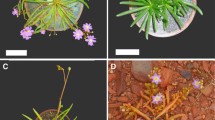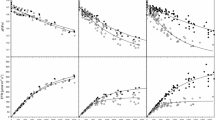Summary
Crassulacean acid metabolism (CAM) was studied in a tropical epiphytic fern, Pyrrosia longifolia, from a fully sun-exposed and from a very shaded site in Northern Queensland, Australia. Measurements of instantaneous net CO2 exchange showed carbon gain via CO2 dark fixation with some net CO2 uptake also occuring during late afternoon, in both sun and shade fronds. Maximum rates of net CO2 uptake and the nocturnal increase in titratable acidity were lower in shade than in sun fronds. δ13C values of sun and shade fronds were not significantly different, and ranged between-14 and-15‰ suggesting that, in the long term, carbon gain was mainly via CO2 dark fixation. Sun fronds had a higher light compensation point of photosynthesis than shade fronds but the same quantum yield. Yet there was no acclimation of photosynthetic O2 evolution, (measured at 5% CO2) in sun and shade fronds and photosynthesis saturated at between 200 and 400 μmol quanta m-2 s-1. Use of higher light intensities for photosynthesis of sun fronds was probably precluded by low nutrient availability. Total nitrogen was less than 1% of dry weight in fully expanded sun and shade fronds. Exposure of shade fronds to full sunlight for 6 h led to a 60% decline in the quantum yield of photosynthesis and to a decline in variable fluorescence measured at room temperature. Photoinhibition by high light was also observed in Hoya nicholsoniae, a rainforest climber growing in deep shade. This species also exhibited CAM as demonstrated by nocturnal net CO2 uptake, nocturnal acidification and a δ13C value of-14‰. Photosynthetic O2 evolution in this species was saturated at 2.5% of full sunlight. Two species of Dendrobium (Orchidaceae) from sun-exposed sites, one species exhibiting CAM and the other one exhibiting net CO2 uptake exclusively during daytime via conventional C3 photosynthesis, showed similar light response curves and the same quantum yield for photosynthetic O2 evolution.
Similar content being viewed by others
References
Adams WW III, Osmond CB (1985) Quantum yield and fluorescence in CAM. Plant Physiol 77 (supplements): 102
Björkman O (1981) Responses to different quantum flux densities. In: Lange OL, Nobel PS, Osmond CB, Ziegler H (eds) Physiological plant ecology I, Encyclopedia of plant physiology, new series, 12A. Springer, Berlin Heidelberg New York, pp 57–102
Boardman NK (1977) Comparative photosynthesis of sun and shade plants. Ann Rev Plant Physiol 28:355–377
Coutinho LM (1969) Novas observacoes sobre a ocorrencia do “efeito de de Saussure” e suas relacoes com a suculencia, a temperatura folhear e os movimentos estomaticos. Botanica 24:79–102
Delieu T, Walker DA (1983) Simultaneous measurement of oxygen evolution and chlorophyll fluorescence from leaf pieces. Plant Physiol 73:534–541
Edwards GE, Foster JG, Winter K (1982) Activity and intracellular compartmentation of enzymes of carbon metabolism in CAM plants. In: Ting IP, Fibbs M (eds) Crassulacean acid metabolism, Proc 5th Annu Symp Bot Univ California, Riverside. Amer Soc Plant Physiol, pp 92–111
Ehleringer J, Pearcy RW (1983) Variation in quantum yield for CO2 uptake among C3 and C4 plants. Plant Physiol 73:555–559
Farquhar GD, Ball MC, von Caemmerer S, Roksandic Z (1982) Effect of salinity and humidity on δ13C value of halophytes evidence for diffusional isotope fractionation determined by the ratio of intercellular/atmospheric partial pressure of CO2 under different environmental conditions. Oecologia (Berlin) 52:121–124
Goh CJ, Avadhani PN, Loh CS, Hanegraaf C, Arditti J (1977) Diurnal stomatal and acidity rhythms in orchid leaves. New Phytol 78:365–372
Griffiths H, Smith JAC (1983) Photosynthetic pathways in the Bromeliaceae of Trinidad: relations between life-forms, habitat preference and the occurrence of CAM. Oecologia (Berlin) 60:176–184
Hew CS (1975) Patterns of CO2 fixation in tropical orchid species. Proceedings 8th World Orchid Conference, 426–430
Hew CS, Wong YS (1974) Photosynthesis and respiration of ferns in relation to their habitat. Amer Fern J 64:40–48
Kluge M, Ting IP (1978) Crassulacean acid metabolism. Springer, Berlin Heidelberg New York
Langenheim JH, Osmond CB, Brooks A, Ferrar PJ (1984) Photosynthetic responses to light in seedlings of selected Amazonian and Australian rainforest tree species. Oecologia 63:215–224
McWilliams EL (1970) Comparative rates of dark CO2 uptake and acidification in the Bromeliaceae, Orchidaceae and Euphorbiaceae. Bot Gaz 131:285–290
Medina E (1971) Effect of nitrogen supply and light intensity during growth on the photosynthetic capacity and carboxydismutase activity in leaves of Atriplex patula ssp. hastata. Carnegie Institution Year Book 70:551–559
Medina E, Delgado M, Troughton JH, Medina JD (1977) Physiological ecology of CO2 fixation in Bromeliaceae. Flora 166:137–152
Nobel PS, Hartsock TL (1983) Relationships between photosynthetically active radiation, nocturnal acid accumulation, and CO2 uptake for a crassulacean acid metabolism plant, Opuntia ficus-indica. Plant Physiol 71:71–75
Osmond CB (1983) Interactions between irradiance, nitrogen nutrition and water stress in sun-shade responses of Solanum dulcamara. Oecologia 57:316–321
Osmond CB, Winter K, Ziegler H (1982) Functional significance of pathways of photosynthetic carbon assimilation. In: Lange OL, Nobel PS, Osmond CB, Ziegler H (eds) Physiological plant ecology II, Encyclopedia of plant physiology, new series, 12B. Springer, Berlin Heidelberg New York, pp 479–547
Richards PW (1964) The tropical rain forest. Cambridge University Press
Sinclair R (1983a) Water relations of tropical epiphytes I. Relationships between stomatal resistance relative water content and the components of water potential. J Exp Bot 34:1652–1663
Sinclair R (1983b) Water relations of tropical epiphytes II. Performance during droughting. J Exp Bot 34:1664–1675
Sinclair R (1984) Water relations of tropical epiphytes III. Evidence for crassulacean acid metabolism. J Exp Bot 35:1–7
Spalding MH, Edwards GE, Ku MSB (1980) Quantum requirement for photosynthesis in Sedum praealtum during two phases of crassulacean acid metabolism. Plant Physiol 66:463–465
Teeri JA (1982) Carbon isotopes and the evolution of C4 photosynthesis and crassulacean acid metabolism. In: Nitecki MH (ed) Biochemical aspects of evolutionary biology. University of Chicago Press, Chicago London, pp 93–130
Wallace BJ (1982) The Australian vascular epiphytes: flora and ecology. PhD thesis, Univ New England, Armidale, Australia
Winter K (1985) Crassulacean acid metabolism. In: Barber J (ed) Topics in photosynthesis, Vol 6. Elsevier, Amsterdam, in press
Winter K, Wallace BJ, Stocker GC, Roksandic Z (1983) Crassulacean acid metabolism in Australian vascular epiphytes and some related species. Oecologia (Berlin) 57:129–141
Wong SC, Hew CS (1976) Diffusive resistance, titratable acidity, and CO2 fixation in two tropical epiphytic ferns. Amer Fern J 66:121–124
Author information
Authors and Affiliations
Rights and permissions
About this article
Cite this article
Winter, K., Osmond, C.B. & Hubick, K.T. Crassulacean acid metabolism in the shade. Studies on an epiphytic fern, Pyrrosia longifolia, and other rainforest species from Australia. Oecologia 68, 224–230 (1986). https://doi.org/10.1007/BF00384791
Received:
Issue Date:
DOI: https://doi.org/10.1007/BF00384791




